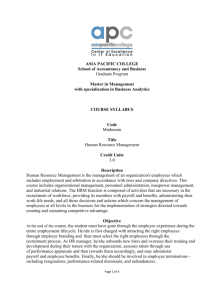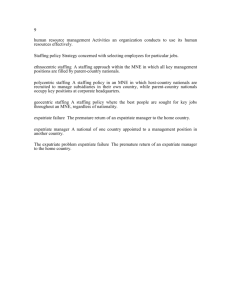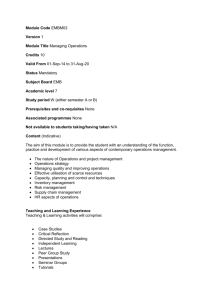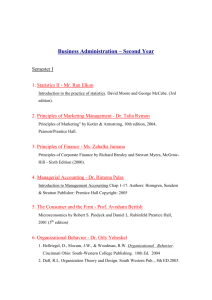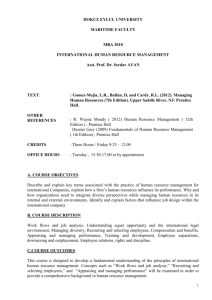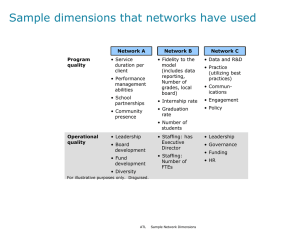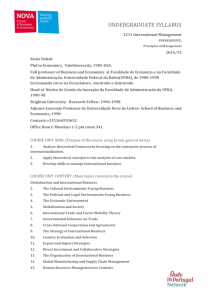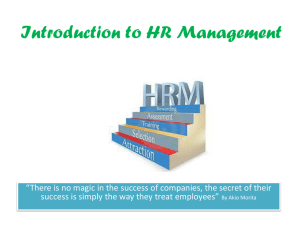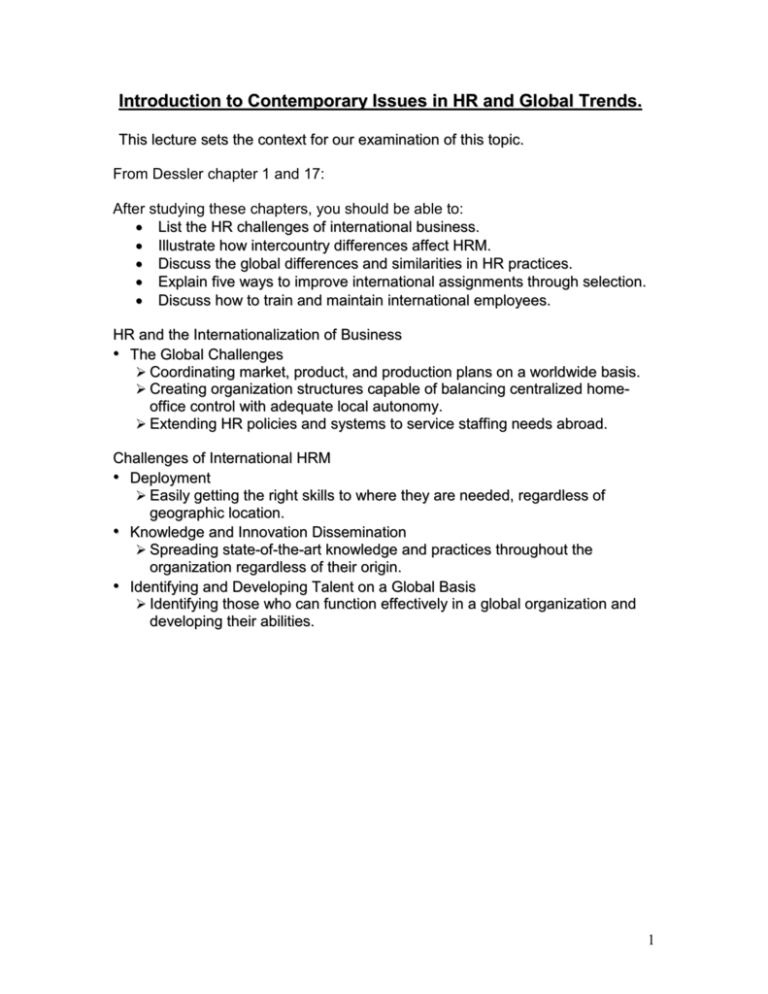
Introduction to Contemporary Issues in HR and Global Trends.
This lecture sets the context for our examination of this topic.
From Dessler chapter 1 and 17:
After studying these chapters, you should be able to:
List the HR challenges of international business.
Illustrate how intercountry differences affect HRM.
Discuss the global differences and similarities in HR practices.
Explain five ways to improve international assignments through selection.
Discuss how to train and maintain international employees.
HR and the Internationalization of Business
• The Global Challenges
Coordinating market, product, and production plans on a worldwide basis.
Creating organization structures capable of balancing centralized homeoffice control with adequate local autonomy.
Extending HR policies and systems to service staffing needs abroad.
Challenges of International HRM
• Deployment
Easily getting the right skills to where they are needed, regardless of
geographic location.
• Knowledge and Innovation Dissemination
Spreading state-of-the-art knowledge and practices throughout the
organization regardless of their origin.
• Identifying and Developing Talent on a Global Basis
Identifying those who can function effectively in a global organization and
developing their abilities.
1
Intercountry Differences Affecting HRM
Intercountry Differences Affecting HRM
Cultural
Factors
Economic
Systems
International
Human Resource
Management
Legal and Industrial
Relations Factors
© 2008 Prentice Hall, Inc. All rights reserved.
17–5
Global Differences and Similarities in HR Practices
Global Differences and Similarities
in HR Practices
Personnel
Selection
Procedure
Use of Pay
Incentives
International
Human Resource
Management
Purpose of
Performance
Appraisal
Training and
Development
Practices
© 2008 Prentice Hall, Inc. All rights reserved.
17–6
2
How to Implement a Global HR System
• Best practices for making a global HR system more acceptable to local
managers:
Remembering that global systems are more accepted in truly global
organizations.
Investigating pressures to differentiate and determine their legitimacy.
Working within the context of a strong corporate culture is best.
A Global HR System (cont’d)
• Best practices for developing a more effective global HR system:
Form global HR networks that make local HR managers a part of global
teams.
Remember that it’s more important to standardize ends and competencies
than specific methods.
• Best practices for implementing the global HR system:
Remember, ―You can’t communicate enough.‖
Dedicate adequate resources for the global HR effort.
TABLE 17–1 Summary of Best Global HR Practices
TABLE 17–1 Summary of Best Global HR Practices
Do . . .
• Work within existing local systems—integrate
global tools into local systems
• Create a strong corporate culture
• Create a global network for system
development— global input is critical
• Treat local people as equal partners in
system development
• Assess common elements across
geographies
• Focus on what to measure and allow flexibility
in how to measure
• Allow for local additions beyond core
elements
• Differentiate when necessary
• Train local people to make good decisions
about which tools to use and how to do so
• Communicate, communicate, communicate!
• Dedicate resources for global HR efforts
• Know, or have access to someone who
knows, the legal requirements in each country
Don’t . . .
• Try to do everything the same way
everywhere
• Yield to every claim that ―we’re
different‖—make them prove it
• Force a global system on local people
• Use local people just for implementation
• Use the same tools globally, unless you
can show that they really work and are
culturally appropriate
• Ignore cultural differences
• Let technology drive your system
design—you can’t assume every location
has the same level of technology
investment and access
• Assume that ―if we build it they will
come‖—you need to market your tools or
system and put change management
strategies in place
Source: Ann Marie Ryan et al., ―Designing and Implementing Global Staffing Systems:
Part 2—Best Practices,‖ Human Resource Management 42, no. 1 (Spring 2003), p. 93.
© 2008 Prentice Hall, Inc. All rights reserved.
17–9
3
Staffing the Global Organization
• International staffing: Home or local?
Expatriates (expats)
Home-country nationals
Third-country nationals
• Offshoring
Having local employees abroad do jobs that the firm’s domestic employees
previously did in-house
• Offshoring Issues
Effective local supervisory/management structure
Screening and required training for locals
Local compensation policies and working conditions
Staffing the Global Organization (cont’d)
Staffing the Global Organization (cont’d)
Top Management Values
Ethnocentric
International
Staffing
Policy
Polycentric
Geocentric
© 2008 Prentice Hall, Inc. All rights reserved.
17–11
4
Staffing the Global Organization (cont’d)
Staffing the Global Organization (cont’d)
Inability of Spouse
to Adjust
Personality
Personal
Intentions
Family
Pressures
© 2008 Prentice Hall, Inc. All rights reserved.
Why Expatriate
Assignments
Fail
Inability to Cope
with Overseas
Responsibilities
Lack of
Cultural Skills
17–12
5
Staffing the Global Organization (cont’d)
Staffing the Global Organization (cont’d)
Realistic Previews
Careful Screening
Helping Expatriate
Assignments Succeed
Improved Orientation
Cultural and Language Training
Improved Benefits Packages
© 2008 Prentice Hall, Inc. All rights reserved.
17–13
6
FIGURE 17–1 Five Factors Important in International Assignee Success,
and Their Components
FIGURE 17–1
Five Factors
Important in
International
Assignee
Success,
and Their
Components
I. Job Knowledge and Motivation
Managerial ability
Organizational ability
Imagination
Creativity
Administrative skills
Alertness
Responsibility
Industriousness
Initiative and energy
High motivation
Frankness
Belief in mission and job
Perseverance
II. Relational Skills
Respect
Courtesy and fact
Display of respect
Kindness
Source: Adapted from
Arthur Winfred Jr., and
Winston Bennett Jr.,
―The International
Assignee: The Relative
Importance of Factors
Perceived to Contribute
to Success,‖ Personnel
Psychology 18 (1995),
pp. 106–107.
Empathy
Nonjudgmentalness
Integrity
Confidence
© 2008 Prentice Hall, Inc. All rights reserved.
III. Flexibility/Adaptability
Resourcefulness
Ability to deal with stress
Flexibility
Emotional stability
Willingness to change
Tolerance for ambiguity
Adaptability
Independence
Dependability
Political sensitivity
Positive self-image
IV. Extracultural Openness
Variety of outside interests
Interest in foreign cultures
Openness
Knowledge of local language(s)
Outgoingness and extroversion
Overseas experience
V. Family Situation
Adaptability of spouse and family
Spouse’s positive opinion
Willingness of spouse to live abroad
Stable marriage
17–14
Selecting Expatriate Managers
• Adaptability Screening
Assessing the assignee’s (and spouse’s) probable success in handling the
foreign transfer.
Overseas Assignment Inventory
A test that identifies the characteristics and attitudes international
assignment candidates should have.
• Realistic Previews
The problems to expect in the new job, as well as the cultural benefits,
problems, and idiosyncrasies of the country.
7
Orienting and Training Employees on International Assignment
• There is little or no systematic selection and training for assignments
overseas.
• Training is needed on:
The impact of cultural differences on business outcomes.
How attitudes (both negative and positive) are formed and how they
influence behavior.
Factual knowledge about the target country.
Language and adjustment and adaptation skills.
Trends in Expatriate Training
• Rotating assignments that permit overseas managers to grow professionally.
• Management development centers around the world where executives hone
their skills.
• Classroom programs provide overseas executives with educational
opportunities similar to stateside programs.
• Continuing, in-country cross-cultural training.
• Use of returning managers as resources to cultivate the ―global mind-sets‖ of
their home-office staff.
• Use of software and the Internet for cross-cultural training.
Compensating Expatriates
• The ―Balance Sheet Approach‖
Home-country groups of expenses—income taxes, housing, goods and
services, and discretionary expenses—are the focus of attention.
The employer estimates what each of these four expenses is in the
expatriate’s home country, and what each will be in the host country.
The employer then pays any differences such as additional income taxes or
housing expenses.
8
TABLE 17–2 The Balance Sheet Approach (Assumes Base Salary of
$80,000)
TABLE 17–2 The Balance Sheet Approach (Assumes Base Salary of $80,000)
Annual Expense
Chicago, U.S.
Housing & utilities
Brussels, Belgium
(U.S.$ Equivalent)
Allowance
$35,000
$67,600
$32,600
6,000
9,500
3,500
Taxes
22,400
56,000
33,600
Discretionary income
10,000
10,000
0
$73,400
$143,100
$69,700
Goods & services
Total
Source: Joseph Martocchio, Strategic Compensation: A
Human Resource Management Approach, 2nd edition (Upper
Saddle River, NJ: Prentice Hall, 2001), Table 12-15, p. 294.
© 2008 Prentice Hall, Inc. All rights reserved.
17–19
Incentives for International Assignments
• Foreign Service Premiums
Financial payments over and above regular base pay, and typically range
between 10% and 30% of base pay.
• Hardship Allowances
Payments to compensate expatriates for exceptionally hard living and
working conditions at certain foreign locations.
• Mobility Premiums
Lump-sum payments to reward employees for moving from one assignment
to another.
9
Appraising Expatriate Managers
• Challenges
Determining who should appraise the manager.
Deciding on which factors to base the appraisal.
• Improving the Expatriate Appraisal Process
Stipulate the assignment’s difficulty level, and adapt the performance
criteria to the situation.
Weigh evaluation more toward the on-site manager’s appraisal than toward
the home-site manager’s.
If the home-office manager does the actual written appraisal, use a former
expatriate from the same overseas location for advice.
International Labor Relations
International Labor Relations
Characteristics of
European Labor
Relations
Industry-Wide
Centralization
Employer
Organization
© 2008 Prentice Hall, Inc. All rights reserved.
Multiple Union
Recognition
Content and
Scope of
Bargaining
17–22
Terrorism, Safety, and Global HR
• Taking Protective Measures
Crisis management teams
• Kidnapping and Ransom (K&R) Insurance
Crisis situations
Kidnapping: the employee is a hostage until the employer pays a
ransom.
Extortion: threatening bodily harm.
Detention: holding an employee without any ransom demand.
Threats to property or products unless the employer makes a payment.
10
Repatriation: Problems and Solutions
• Problem
Making sure that the expatriate and his or her family don’t feel that the
company has left them adrift.
• Solutions
Match the expat and his or her family with a psychologist trained in
repatriation issues.
Make sure that the employee always feels ―in the loop‖ with what’s
happening back at the home office.
Provide formal repatriation services when the expat returns home.
K E Y T E R M S so far
codetermination
expatriates (expats)
home-country nationals
third-country nationals
offshoring
ethnocentric
polycentric
geocentric
adaptability screening
foreign service premiums
hardship allowances
mobility premiums
11
The Changing Environment of Human Resource Management
The Changing Environment of
Human Resource Management
Globalization Trends
Changes and Trends
in Human Resource
Management
Technological Trends
Trends in the Nature of Work
Workforce Demographic Trends
© 2008 Prentice Hall, Inc. All rights reserved.
17–26
12
FIGURE 1–4 Employment Exodus: Projected Loss of Jobs and Wages
FIGURE 1–4
Employment Exodus: Projected Loss of Jobs and Wages
Source: Michael Schroeder, ―States Fight Exodus of Jobs,‖ Wall Street Journal, June 3, 2003,
p. 84. Reproduced with permission of Dow Jones & Co. Inc. via Copyright Clearance Center.
© 2008 Prentice Hall, Inc. All rights reserved.
17–27
13
The Changing Role of Human Resource Management
The Changing Role of
Human Resource Management
Strategic Human
Resource
Management
Managing with the
HR Scorecard
Process
New
Responsibilities
for HR Managers
Creating HighPerformance Work
Systems
Measuring the HRM
Team’s Performance
© 2008 Prentice Hall, Inc. All rights reserved.
17–28
TABLE 1–1 Technological Applications for HR
TABLE 1–1
Technological Applications for HR
Application Service Providers (ASPs) and technology outsourcing
Web portals
PCs and high-speed access
Streaming desktop video
The mobile Web and wireless net access
E-procurement
Internet- and network-monitoring software
Bluetooth
Electronic signatures
Electronic bill presentment and payment
Data warehouses and computerized analytical programs
© 2008 Prentice Hall, Inc. All rights reserved.
17–29
14
High-Performance Work System Practices
• Employment security
• Selective hiring
• Extensive training
• Self-managed teams/decentralized decision making
• Reduced status distinctions
• Information sharing
• Contingent (pay-for-performance) rewards
• Transformational leadership
• Measurement of management practices
• Emphasis on high-quality work
Benefits of a High-Performance W ork System (HPW S)
• Generate more job applicants
• Screen candidates more effectively
• Provide more and better training
• Link pay more explicitly to performance
• Provide a safer work environment
• Produce more qualified applicants per position
• Hiring based on validated selection tests
• Provide more hours of training for new employees
• Conduct more performance appraisals
FIGURE 1–5 Five Sample HR Metrics
FIGURE 1–5
Five Sample HR Metrics
HR Metric*
How to Calculate It
Absence rate
# of days absent in month
Average # of employees during month × # of workdays
Cost per hire
× 100
Advertising + agency fees + employee referrals + travel cost of
applicants and staff + relocation costs + recruiter pay and benefits
Number of hires
HR expense
factor
Time to fill
HR expense
Total operating expense
Total days elapsed to fill job requisitions
Number hired
Turnover rate
Number of separations during month
Average number of employees during month
× 100
Sources: Robert Grossman, ―Measuring Up,‖ HR Magazine, January 2000, pp. 29–35; Peter V. Le Blanc, Paul Mulvey, and Jude T. Rich, ―Improving the Return on Human Capital: New Metrics,‖
Compensation and Benefits Review, January/February 2000, pp. 13–20; Thomas E. Murphy and Sourushe Zandvakili, ―Data and Metrics-Driven Approach to Human Resource Practices: Using
Customers, Employees, and Financial Metrics,‖ Human Resource Management 39, no. 1 (Spring 2000), pp. 93–105; [HR Planning, Commerce Clearing House Incorporated, July 17, 1996;]
SHRM/BNA 2000 Cost Per Hire and Staffing Metrics Survey; www.shrm.org. See also, SHRM Research ―2006 Strategic HR Management Survey Report,‖ Society for Human Resource Management..
© 2008 Prentice Hall, Inc. All rights reserved.
17–32
15
Measuring HR’s Contribution
• The HR Scorecard
Shows the quantitative standards, or ―metrics‖ the firm uses to measure HR
activities.
Measures the employee behaviors resulting from these activities.
Measures the strategically relevant organizational outcomes of those
employee behaviors.
The Human Resource Manager’s Proficiencies
• New Proficiencies
HR proficiencies
Business proficiencies
Leadership proficiencies
Learning proficiencies
FIGURE 1–6 Effects CFOs Believe Human Capital Has on Business
Outcomes
FIGURE 1–6 Effects CFOs Believe Human Capital Has on Business Outcomes
Source: Steven H. Bates, ―Business Partners,‖ HR Magazine, September 2003, p. 49. Reproduced
with permission of the Society for Human Resource Management via Copyright Clearance Center.
© 2008 Prentice Hall, Inc. All rights reserved.
17–35
HR Certification
• HR is becoming more professionalized.
• Society for Human Resource Management (SHRM)
16
SHRM’s Human Resource Certification Institute (HRCI)
SPHR
(senior professional in HR)
(professional in HR)
certificate
certificate
PHR
FIGURE 1–7 2004 SHRM® Learning System Module Descriptions
17
The Human Resource Manager’s Proficiencies (cont’d)
• Managing within the Law
Equal employment laws
Occupational safety and health laws
Labor laws
• Managing Ethics
Ethical lapses
KEY TERMS
management process
human resource management
(HRM)
authority
line manager
staff manager
line authority
staff authority
implied authority
functional control
employee advocacy
globalization
human capital
strategy
strategic plan
metrics
HR Scorecard
outsourcing
ethics
strategic human resource management
high-performance work system
Reference
Dessler, G. Human Resources Management 2008, New Jersey, Pearson
18

